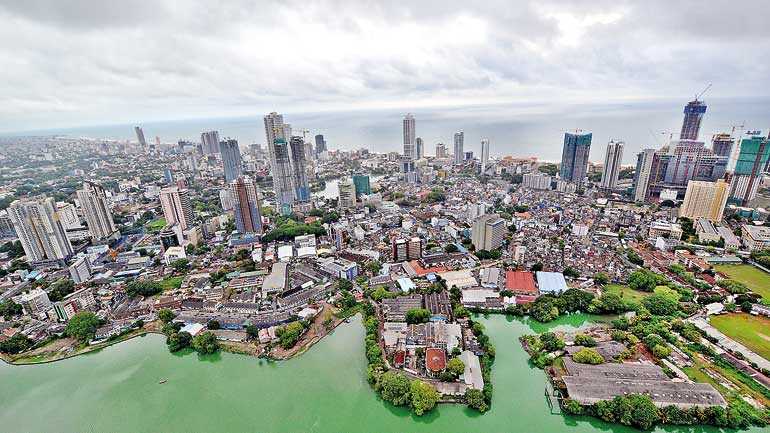Saturday Apr 05, 2025
Saturday Apr 05, 2025
Tuesday, 11 February 2020 00:22 - - {{hitsCtrl.values.hits}}

Utilise Sri Lanka’s strategic position to negotiate with world powers such as USA and China (or any other country for that matter) to get what we need most, i.e., technology and market for such technological products and services. In return, we should be prepared to offer them benefits without materially affecting Sri Lanka’s security or sovereignty. This is the best way to leapfrog the economy – Pic by Shehan Gunasekara
A knowledgeable individual gave his frank opinion of the economic strategy that I have proposed – “it is too risky”. Of course, I respect his opinion. However, though it may appear risky, in my mind what’s more risky is a continuation of the path that we have taken over the last so many decades. Although many wouldn’t realise, a continuation of that path would lead us to an economic halt possibly within the next 10 years.
First and foremost is the external current account deficit of Sri Lanka. To put simply, Sri Lanka needs to borrow $ 2 b or more every year simply to finance the import bill. While some are concerned that Sri Lanka would struggle to service its foreign debt, the reality is Sri Lanka has to borrow over and above the need to just service the existing debt.
There doesn’t seem to be a practical, well-thought-out strategy to rectify this. In fact, as the Sri Lankan economy is dependent on imports, any sort of an economic revival in the current form would only result in a further expansion of the external current account deficit. Therefore, import restrictions measures are a certainty in the coming years – simply because we wouldn’t have enough foreign currency to import.
Secondly, the inevitable rise in foreign borrowings to finance the import bill would continuously strain the debt servicing capability. As we have moved to middle income status, the  concessionary loan facilities have dried up as the rest of the world needs us to stand on our own feet, rather than depending on concessions.
concessionary loan facilities have dried up as the rest of the world needs us to stand on our own feet, rather than depending on concessions.
The credit rating agencies would be looking to downgrade the country rating and raising borrowings would always be a challenge in the absence of a concrete long term plan to rectify the deficit in the external current account. We have had IMF bailouts twice over the last 10 years and another is likely within the next 10 years. The conditions are going to be a lot more stringent next time.
The above formidable challenges would curtail the economic growth. It’s not an accident that many countries get in to the so called “middle income trap”. To break it and get to “developed” state, needs smart, practical strategising and swift implementing which only a handful of countries have done in the last several decades. Therefore, the per capita income is unlikely to exceed $ 6,000 (from the current level of $ 4,000) anytime soon. In fact, it may not go beyond $ 5,000 by 2030.
Lack of (or slow) economic progress would open up a number of other challenges. The social unrest which would turn to political unrest in our democratic environment would be inevitable. The brain drain is only going to speed up as skilled professionals realise that prospects are minimal by staying in Sri Lanka. As a result, we would be in a vicious cycle. Breaking that cycle would be an uphill task. It is therefore that I proposed a strategy, which indeed takes up calculated risks, to avoid the middle income trap.
Sri Lanka is in dire need of a major economic shift – from an import driven consumption based economy to an investment driven export based economy. It is the exact opposite of China going through right now (from export driven to consumption driven). This shift has to take place gradually over the next 10 years to avoid the above mentioned economic precipice. That would not happen through lip service.
Abrupt, knee-jerk import restrictions we have witnessed in the past have always resulted in distress among the segments that were subjected to such restrictions. That trickles down to other segments of the economy as piling up of non-performing loans affect banks and inter-connection of segments makes it inevitable for most segments to get negatively affected. A slowdown of the economy is a certainty.
That’s exactly why it has to be planned. The importers should be aware that over the next 10 years they should gradually reduce exposure to importing finished goods and move towards importing basic products/services and adding greater value domestically and also shift to export segments.
This direction should be given by the Government. At the very minimum it should be through, incentives and concessions for value addition and export segments and maintaining (and even increasing) taxes for finished goods importers. In that light, across the board tax concessions for all segments could not be perceived as prudent.
Coming back to what I have proposed in my book, a key aspect is to utilise Sri Lanka’s strategic position to negotiate with world powers such as USA and China (or any other country for that matter) to get what we need most, i.e., technology and market for such technological products and services. In return, we should be prepared to offer them benefits without materially affecting Sri Lanka’s security or sovereignty. This is the best way to leapfrog the economy. Secondly, the Government should invest to produce the labour force (and other infrastructure and concessions) needed to boost foreign currency earning segments. That should happen even at the expense of a widening fiscal deficit. If the need arises, such deficit could be financed by non-conventional measures – we got to take calculated risks.
In my mind, none of that is more risky than what’s mentioned earlier. Let’s make no mistake, we are slowly but surely moving towards an absolute economic halt.
(The writer can be contacted on [email protected].)
Discover Kapruka, the leading online shopping platform in Sri Lanka, where you can conveniently send Gifts and Flowers to your loved ones for any event including Valentine ’s Day. Explore a wide range of popular Shopping Categories on Kapruka, including Toys, Groceries, Electronics, Birthday Cakes, Fruits, Chocolates, Flower Bouquets, Clothing, Watches, Lingerie, Gift Sets and Jewellery. Also if you’re interested in selling with Kapruka, Partner Central by Kapruka is the best solution to start with. Moreover, through Kapruka Global Shop, you can also enjoy the convenience of purchasing products from renowned platforms like Amazon and eBay and have them delivered to Sri Lanka.
Discover Kapruka, the leading online shopping platform in Sri Lanka, where you can conveniently send Gifts and Flowers to your loved ones for any event including Valentine ’s Day. Explore a wide range of popular Shopping Categories on Kapruka, including Toys, Groceries, Electronics, Birthday Cakes, Fruits, Chocolates, Flower Bouquets, Clothing, Watches, Lingerie, Gift Sets and Jewellery. Also if you’re interested in selling with Kapruka, Partner Central by Kapruka is the best solution to start with. Moreover, through Kapruka Global Shop, you can also enjoy the convenience of purchasing products from renowned platforms like Amazon and eBay and have them delivered to Sri Lanka.